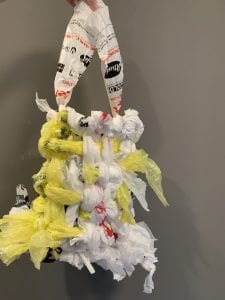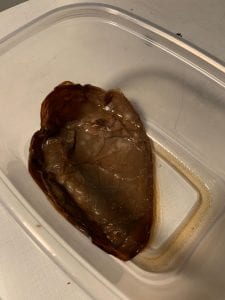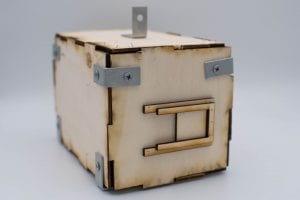Plastic Bag Project:
Tote bag made of woven plastic bags using a lou.
For this project we were tasked with creating a usable object only with plastic bags. I decided to recreate a classic Parsons student staple: the tote bag. To do this I created a lou by cutting slices out of a piece of cardboard, cutting the plastic bags in half, wrapping them around the lou and tying a not with the handles, then weaving the plastic bags on both sides. I did a smaller version of this for the bottom and took one big plastic bag, cut it, and tied notes with the handles to attach it to the rest of the bag. The life cycles of this project are the oil used in creating the plastic bags, and the trees used to create the cardboard, along with oil and pollution used in the transportation involved in creating both products.
Kombucha Project:
If grown in a sealed container (not air tight) kombucha-SCOBY, brewed tea, sugar, vinegar, and water-will form a layer of glucose at the top and is a sustainable substitute of leather that does not involve the harm of animals. We were tasked with creating a usable object out of this ‘kombucha leather’ by letting it dry and folding it into an object. Due to complications with my kombucha I was unable to create a product.
Reclaimed Materials Project:
Pinhole camera made of reclaimed wood, reclaimed screws and L brackets, nails provided by Parsons free of charge, staples free of charge, and an old t shirt.
For this project we were tasked with creating a product only using reclaimed materials. I chose to construct a pinhole camera using the list of reclaimed materials above, including using a nail gun, drill, and the laser printer. I wanted to create something that I would be able to use in my artwork and as creating a fully functional film camera would be relatively impossible, I decided to create a pinhole camera. I focussed on the design aesthetic, wanting to create a minimalist camera out of wood that was sleek and simple, using the laser lab. As I worked on this project I realized I would need more than just wood, and ended up using metal to attach the wood together and the T shirt as a way to prevent excess light from entering. There were a large number of life cycles involved in the production of this product and in future I would create a sustainable adhesive that would allow me to attach the wood together without using metal, and I would have also used 1/4 inch wood instead of the 1/8 inch bending ply that made attaching the pieces together difficult along with allowing for light leaks.



